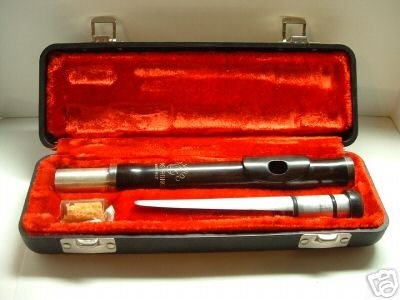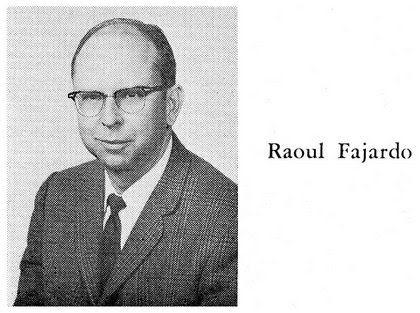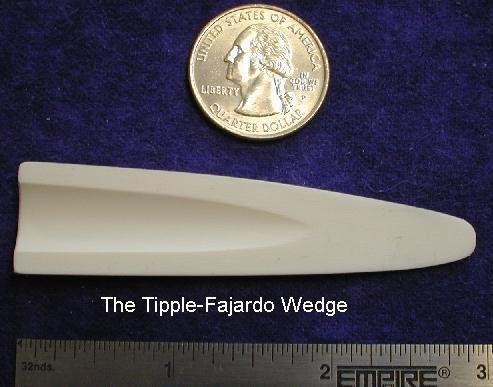I now install the wedge into the headjoint on all of my flutes. I no longer consider the wedge an accessory but an integral part of the flute. The installed wedge is included in the price of the flute. If you are interested in the historical development of the Tipple-Fajardo wedge, please read the following comments.
For some time I have been working on an idea to help improve the performance of my PVC flutes. One of the inherent shortcomings of cylindrical bore flutes is that the upper part of the second octave begins to go slightly flat. Veteran players of the flute are able to compensate for this by blowing in the note (blowing harder), but this is hard for beginners to learn to do. I have developed a small wedge that is inserted into the bore of the flute that eliminates this intonation problem in the second octave. This wedge accomplishes the same objective as the parabolic or linear taper in the Boehm headjoint of the modern silver flute. The wedge also makes the flute tone more complex, sounding more like a wooden Irish flute, although it should be noted that a good player can accomplished with her personal embouchure alone. Raoul Fajardo patented a similar idea in 1977, and that patent is now in public domain. The Armstrong Flute Company manufactured a wooden headjoint with a cylindrical bore using the Fajardo wedge, but the product was not a commercial success. Their intent was to make a wooden headjoint for a silver flute, with the resulting tone being like a Baroque flute.
I recently was the lucky ebaywinner of an Fajardo-Armstrong wooden headjoint with a Fajardo wedge/stopper.
Using the patent drawings and adjusting the measurements for a slightly larger bore, I have experimented with wedges from different materials that are identical to the Fajardo wedge. I found that the Fajardo wedge, when used in my PVC flutes, sharpens the second octave notes way too much. Trying to use material shapes that are readily available, I have developed a wedge with a convex-concave cross-sectional area. It is made from another piece of smaller diameter PVC tubing that has nearly the same outside diameter as the inside diameter of my low D flutes. The wedge is very easy to use, in that you simply drop in into the bore of the flute until it rests against the stopper. You can use it as a floating insert, or it can easily be glued in place.
If you decide to glue the wedge in place, here is the method that I suggest for doing that. First make sure that the tuning cork is in the standard position. The formula is: bore diameter = distance from stopper to center of blow hole. For customers who purchased a flute without the wedge, I sometimes set the stopper closer than this to improve second octave intonation without the wedge. To use the wedge you will need to readjust the stopper to the abovementioned distance. The way that I use to set the postion of the stopper or tuning cork is to make a dot on a wooden dowel or any object that you can insert into the headjoint of the flute. Position the dot on the stick so that it is one diameter’s distance from the end of the stick. Now position the end of the dowel against the stopper until the dot is visible in the center of the embouchure hole. The tuning cork should now be in the standard position.
Now slide the wedge into the bore of the flute until it rests with the thicker end against the stopper (see drawing below). It is easier to glue the wedge with the headjoint separated from the flute body. That way you can see the exact position of the wedge prior to gluing. Some players have found that the wedge is best positioned in the flute body with a rotation of about 45-60 degress toward the player. Update: I am now gluing the wedge in the headjoint with superglue as a default procedure.
Securing the wedge: There are a variety of different ways to secure the wedge in the headjoint. I like to use a toothpick and place very small amounts of superglue on the edge of the wedge as it rests in position in the headjoint. I insert the toothpick through the embouchure hole, being careful not to get glue on the edge of the embouchure hole. The following is what I wrote to a recent customer who inquired about how to secure the wedge in the headjoint.
“I have found that it isn’t necessary for the wedge to be exactly the same curvature as the bore of the headjoint, just as long as it’s close. Right now I am using Scotch removable double-coated tape on the surface of the wedge. I use three strips of tape from side to side on the wedge, and I trim the excess tape from the edges of the wedge with scissors or a knife. With the headjoint separated from the flute body, I drop the wedge with tape into the headjoint and move the wedge around until I have it in the position that I think is best, rotated inward toward the player somewhat (see illustration at the bottom of this page). I then press it into place with a stick or small screwdriver through the embouchure hole and from the end of the headjoint. You can test blow it until you are satisfied with the position of the wedge. At this point with a toothpick through the embouchure hole I apply a small amount of liquid superglue to both edges of the wedge at a few points. The superglue will flow into the wedge-tape-bore interface and bond the wedge in the headjoint. If you don’t use too much superglue, it should be possilbe to break the wedge loose with a screwdriver under the tip of the wedge, which tends to curl up a little bit, not affecting the effectiveness of the wedge.”
Michael Eskin, an Irish flute session player and teacher in San Diego, CA, said this about my three-piece, low D PVC Irish flute with the Tipple-Fajardo wedge: “Awesome. Freakin’ awesome. The wedge in the 3-piece flute was amazing. With the wedge, everyone listening was all in agreement that you have something here that could significantly displace the sub-$500 student flutes. My friend was playing the best large-holed wooden keyles flute I’ve ever owned, and the folks listening said that they had a hard time telling them apart. That’s one hell of a compliment.” I am pleased that Michael has been willing to record a 51 sec. clip (mp3, 803KB) of an Irish tune, “Maids of Mt. Cisco”, playing the Tipple 3-piece, white PVC Irish flute with the Tipple-Fajardo wedge in place. This same clip is on my audio files page.
Audio clip: Adobe Flash Player (version 9 or above) is required to play this audio clip. Download the latest version here. You also need to have JavaScript enabled in your browser.
After purchasing a Tipple-Fajardo wedge for his 3-piece Tipple flute in white PVC, a musician in Ohio wrote, “I’ve been playing my flute with your ‘magic wedge’, and I am extremely pleased with the transition. Immediately I noticed that the notes in the upper octave played tighter and on pitch, but even more impressive was the overall personality change of the flute itself. The wonderful in-your-face volume has been replaced by a sublime sweetness very indicative of a fine, African Blackwood Irish flute that I played awhile back. Yesterday I was playing a great Tipple flute. Today I’m playing a Tipple Stradivarius. This wedge has given my flute real soul.”
Having sold many wedges at this point, I want to share some feedback from my customers about the wedge. Some of my customers have found that playing the flute with the wedge is more challenging than playing the flute without the wedge. However, I have a number of performing Irish session musicians who love playing with the wedge. Personally, I recommend playing with the wedge because it does improve intonation significantly. However, for those individuals who for whatever reason would rather not use a wedge in their flute, it should be noted that the intonation problems can also be corrected with alternate fingerings. I have given a few of these at the bottom of the Irish Flute Fingerchart page. To wedge or not to wedge; that is the question. As a default, I now am installing the wedge in the headjoint for those customers who order a wedge. I’m using the double-sided tape/superglue method described above. I will gladly send the wedge unattached if you would prefer that
I am selling the Tipple-Fajardo wedge as an accessory to any of my large-bore tunable flutes. The price is $10 + $1 for shipping and handling in the USA (disregard the shipping charge if the wedge is purchased along with a flute). The international shipping expense will be slightly higher, so please inquire.









